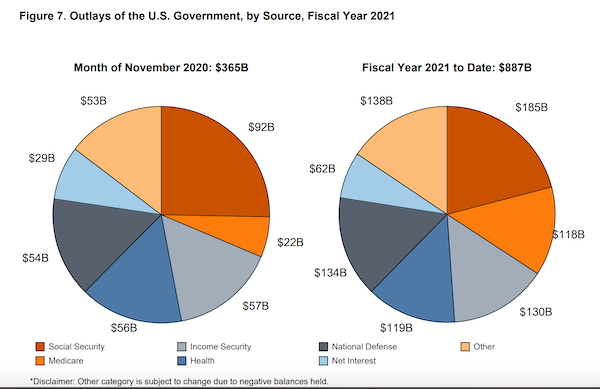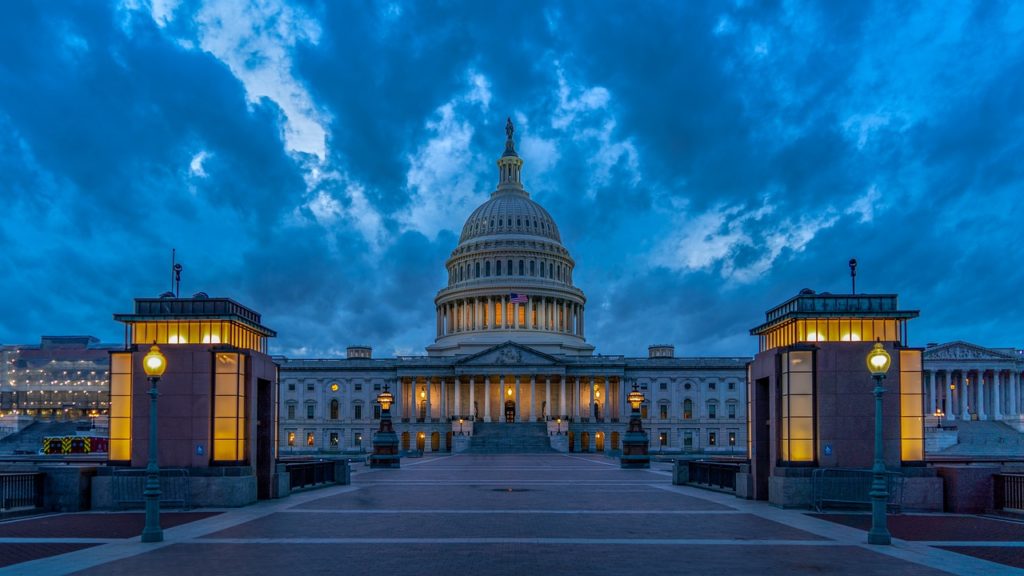US Government Runs Yet Another Really Big Deficit in November
The US government kicked off fiscal 2021 with the biggest October deficit in history. But with the first of November falling on a weekend, some November spending got shifted into October, inflating that month’s deficit. Now that we have the November monthly Treasury Statement, we have a better sense of how big deficits are running in the new fiscal year.
In two words — really big.
The November deficit came in at $145.3 billion. Some people wanted to spin this as good news because it was lower than the November 2019 deficit at $208.8 billion. But you have to factor in those calendar effects. The best way to gauge the budget shortfall through the first two months of FY2021 is to compare it to the deficit through the first two months of fiscal 2020.
The total deficit so far in fiscal 2021 comes to $429.3 billion. That compares to $343.3 billion in October and November 2020. In other words, through the first two months of the new fiscal year, the deficit is running $85.7 billion ahead of last year.
To add a little more perspective, the US government is nearly halfway to a $1 trillion deficit in just the first two months of the fiscal year. Before last year, the federal government had only run $1 trillion deficits four times – all during the Great Recession.
Spending over the last two months came in at a staggering $886.7 billion. That compares to $814 billion through the first two months of fiscal 2020 — an 8.9% increase. Meanwhile, receipts to the US Treasury fell from $470.7 through the first two months of FY2020 to $457.3 billion in October and November of this year.

As of Dec. 9, the national debt stood at $27.41 trillion. According to the National Debt Clock, the debt-to-GDP ratio is 128.59%. Despite the lack of concern in the mainstream, debt has consequences. Studies have shown that a debt to GDP ratio of over 90% retards economic growth by about 30%. This throws cold water on the Republican mantra “we can grow ourselves out of the debt.”
Most people shrug off these massive deficits, reasoning that they are simply a product of the economic problems caused by the coronavirus. But the pandemic has papered over an ugly truth – the federal government was getting into near-record deficit territory before COVID-19 arrived on the scene.
In fiscal 2019, the Trump administration ran a $984 billion deficit. At the time, it was the fifth-largest deficit in history. The upward trajectory continued through the first two months of fiscal 2020, with the budget shortfall running 12% over 2019’s huge number.
And the current massive budget deficit doesn’t factor in any additional COVID-19 stimulus that Congress will almost certainly pass in the coming year.
According to a CBO report, on the current trajectory, the size of the national debt will be nearly double the size of the US economy by 2050.
A lot of people claim massive deficits and ballooning debt don’t matter. After all, the US government has been borrowing money for decades and the doomsday predictions haven’t come to pass. But debt is neither free nor is it irrelevant. Borrowed money has to be paid back – either through taxation or inflation – which is nothing more than a hidden tax.
In fact, the Federal Reserve makes all of this borrowing and spending possible by backstopping the bond market and monetizing the debt. The central bank buys US Treasuries on the open market with money created out of thin air (debt monetization). This creates artificial demand for bonds and keeps interest rates low.
The Fed now owns a record 16.5% of all the outstanding US public debt. In the last 12 months, the Fed has doubled its holdings of Treasuries, adding a staggering $2.4 trillion in US government bonds to its balance sheet – most of that since March. The Fed has monetized the equivalent of almost all the debt the US has issued in the last year. All of the money printed to buy all of this US debt is, by definition, inflation. That means it is devaluing your money as a matter of policy.
Even with the incredible amount of quantitative easing the Fed is engaged in today, many analysts expect another $3 trillion deficit in 2021 with additional stimulus spending needed to prop up the economy in the aftermath of COVID-19. According to Bank of America analysis, the Fed will need to double QE in 2021 just to keep up with the government’s projected debt issuance.
You can try to paper over the surging deficits and ballooning debt by claiming it is “necessary” to fight the coronavirus. The excuse certainly creates good political cover for Trump and other free-spending politicians in both political parties. But you can’t paper over the economic consequences of over-spending and debt. There is no such thing as a free lunch – even if you own a money printing press.





 Since Nayib Bukele became president of El Salvador, El Salvador has been in American media and global political discussion more than ever. While much of the attention focuses on Bukele’s mass incarceration of gang members and a decline in homicide of over 70%, Bukele has also drawn attention to his favoritism towards Bitcoin and how he […]
Since Nayib Bukele became president of El Salvador, El Salvador has been in American media and global political discussion more than ever. While much of the attention focuses on Bukele’s mass incarceration of gang members and a decline in homicide of over 70%, Bukele has also drawn attention to his favoritism towards Bitcoin and how he […] With gold hitting yet another awe-inspiring all-time high in the wake of Powell’s remarks reassuring markets (more or less) to expect rate cuts in 2024, a few analysts are pointing out risk factors for a correction — so is there really still room to run?
With gold hitting yet another awe-inspiring all-time high in the wake of Powell’s remarks reassuring markets (more or less) to expect rate cuts in 2024, a few analysts are pointing out risk factors for a correction — so is there really still room to run? Gold hit a new all-time nominal high, surpassing the previous record set in December of the previous year. The precious metal’s price reached approximately $2,140, indicating a robust and continuing interest in gold as a safe-haven asset, despite a rather peculiar lack of fanfare from the media and retail investors. This latest peak in gold […]
Gold hit a new all-time nominal high, surpassing the previous record set in December of the previous year. The precious metal’s price reached approximately $2,140, indicating a robust and continuing interest in gold as a safe-haven asset, despite a rather peculiar lack of fanfare from the media and retail investors. This latest peak in gold […] The gold price has been surging, with unprecedented central bank demand gobbling up supply. It has been a force to behold — especially as US monetary policy has been relatively tight since 2022, and 10-year Treasury yields have rocketed up, which generally puts firm downward pressure on gold against USD.
The gold price has been surging, with unprecedented central bank demand gobbling up supply. It has been a force to behold — especially as US monetary policy has been relatively tight since 2022, and 10-year Treasury yields have rocketed up, which generally puts firm downward pressure on gold against USD.  Total gold demand hit an all-time high in 2023, according to a recent report released by the World Gold Council. Last week, the World Gold Council (WGC) released its Gold Demand Trends report, which tracks developments in the demand for and use of gold around the world. Excluding over-the-counter (OTC) trade, 2023 gold demand fell slightly from 2022 […]
Total gold demand hit an all-time high in 2023, according to a recent report released by the World Gold Council. Last week, the World Gold Council (WGC) released its Gold Demand Trends report, which tracks developments in the demand for and use of gold around the world. Excluding over-the-counter (OTC) trade, 2023 gold demand fell slightly from 2022 […]